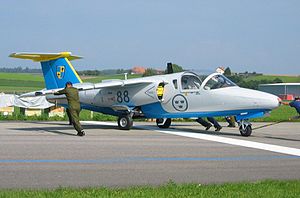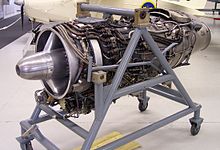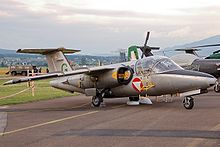Saab 105
| Saab 105 | |
|---|---|
 Saab SK 60 of the Swedish Air Force |
|
| Type: | |
| Design country: | |
| Manufacturer: | |
| First flight: |
June 29, 1963 |
| Commissioning: |
1966 |
| Number of pieces: |
191 |
The Saab 105 is a jet-powered shoulder wing aircraft from the Swedish manufacturer Saab . A special feature are the pilots' seats next to each other and the T- tail unit . It was created on the basis of a civil business aircraft. In addition to its main use as a training aircraft , it was and is also used as a combat and reconnaissance aircraft.
history
Development of the Saab 105 began in the late 1950s. The first flight of the first prototype took place on June 29, 1963 with the test pilot Karl-Erik Fernberg. Sweden first ordered 130 machines in 1962, but later increased the order to 150. A second prototype first flew on June 17, 1964. After a few changes to the wing and engine, the first production aircraft took off for its maiden flight on August 27, 1965. The Swedish Air Force received its 150 machines between 1966 and 1969, which were designated as SK 60. The machines were equipped with a license version of the Turboméca -Aubisque engine , the RM 9, delivering 742 kp of thrust . From 1970, 46 machines received external load stations for 30 mm cannon containers or unguided rockets. These machines were given the designation SK 60B. A reconnaissance variant with installation space for cameras in the bow was given the designation SK 60C. The basic version was later called the SK 60A.
Further variants were the SK 60D, a connection and training variant with four seats and the SK 60E, also with four seats, but with non-military avionics . With all variants it is possible to exchange the two military ejection seats for four conventional seats.
Between 1988 and 1991, all 142 SK 60s still in service with the Swedish Air Force received structural reinforcements and changes to the ejection seats to allow the use of an improved parachute. From 1995, 105 machines were fitted with Williams FJ 44-1C (RM 15) engines and new instruments. The type designations remained the same. These converted machines are only used for training purposes and as liaison aircraft. They are expected to remain in service until 2015. Machines of this type are used by the Swedish aerobatic team Team 60 .
Saab 105 OE
The export version Saab 105XT was delivered to Austria from 1970 and was called the Saab 105 OE there . At the beginning of 2009 the type is still in use in both countries; the duration of deployment is planned in both Sweden and Austria until after 2015. Both air forces are currently negotiating a cockpit update with the industry, which should enable the use of a reduced fleet beyond 2020. In this case, however, it is only intended to be used as a jet trainer.
Austria's armed forces owned 40 Saab 105 OE, of which 22 were still airworthy in December 2010. Twelve machines are being renovated. The navigation equipment in particular is being adapted to the new ICAO guidelines. So far, one machine has been modernized and is being tested. The Saab 105 are currently still used by the jet trainer squadron / surveillance squadron.
The Saab 105 OE can be used for training (main task) and airspace monitoring. Other uses are VIP transports in 4-seater versions. Today only a subordinate role in the armed forces plays as a fighter-bomber and reconnaissance aircraft .
The armament consists of automatic cannons (in MG- arms containers ). In addition, until a few years ago, the 105 OE could also be equipped with unguided rockets as well as reconnaissance and air sample containers .
In November 2019, the fleet, around a dozen machines were still airworthy, was shut down due to damaged bolts. The bolts were reproduced and will be installed from February 2020 to make the machines airworthy again. This measure is said to have cost around 39,000 euros.
Aerobatics
Austria presented in 1974 with Captain Rathgeb and in 1979 with the former Air Force Chief, GenMjr. Erich Wolf , twice the military aerobatic world champion on Saab 105. In addition, the Austrian aerobatic teams " Silver Birds " and later the " Karo As " team flew on Saab 105.
Special paints
- Machine YA-01: Tiger design, crashed in 1995
- Machine GF-16: Tiger-Design as the successor of YA-01 until today
- Machine GG-17: special painting 30 years Saab 105
- Machine RF-26: special painting 40 years of Saab 105, tiger design
Incidents
On January 9, 1973, a Saab 105 OE ( GH-18 ) crashed a few meters from the runway at Vogler Air Base and went up in flames. The two pilots, Captain Leopold H. and First Lieutenant Hans Georg H., were killed. Squadron commander Hauptmann H. was considered by flight experts to be the best aviator in the army at the time.
On August 6, 1981, a Saab 105 OE ( GI-19 ) took off from Brumowski Air Base for an orientation flight in the direction of Zeltweg . After a few minutes of flight time and an actually completed low-level flight passage, the aircraft crossed the municipal area of Gaaden at a far too low altitude and then sped into the village of Grub . The machine crashed into the house of Karl Musil , solo dancer at the Vienna State Opera . Karl Musil and his wife were critically injured, their two children and a neighbor's child were seriously injured. The two pilots, Major Alois S. and Lieutenant Gerhard W., perished. The crash caused extensive property damage in Grub, and the power supply was also interrupted for hours.
On March 3, 1995, two Saab 105 OE ( YA-01 and YA-05 ) took off from Vogler Air Base in order to carry out a system check for the air surveillance system in the direction of Katschberg - Innerkrems - Hochkönig and back. Klaus G. ( YA-05 ), who is considered to be very experienced and serves as a flight instructor , was assigned to the squad leader to lead the two less experienced pilots, Ensign Johann P. and Sergeant Manfred F. (YA-01). Since Klaus G.'s son and wife were in the Innerkrems ski area on that day, he deviated from the given course without consulting the accompanying machine or a supervisor and flew over the chairlift stations of the ski area with a barrel roll to “visit relatives” . Ensign P., with the intention of being "tested" by the Rottenführer, also began the barrel role that was unexpectedly introduced and never practiced, but got too deep and hit the western slope of the Sauereggnock . Ensign P. and mitgeflogene as a technician in the machine sergeant F. were dead on the spot. In 1997 Klaus G. from the Oberlandesgericht Graz for manslaughter under especially dangerous conditions, as well as violation of the rules of the air to a prison sentence of twelve months on probation sentenced in addition, his flight license was revoked.
variants
- Saab 105 : prototype
- SK 60A : two-seater trainer with two ejection seats (later converted to Sk60D) for the Swedish Flygvapnet (Air Force)
- SK 60B : two-seater light fighter aircraft for the Swedish Flygvapnet
- SK 60C : reconnaissance variant for the Swedish Flygvapnet
- SK 60D : Connection variant in which the two ejection seats were replaced by four airliner seats for the Swedish Flygvapnet
- SK 60E : like SK 60A, but with civil avionics and ILS for the Swedish Flygvapnet for training
- SK 60W : Proposal of an improved variant for the Swedish Flygvapnet with two Williams Rolls FJ44 engines with FADEC and MFD
- Saab 105XT : proposed variant of an improved SK 60B for export
- Saab 105D : proposed variant as a business jet
- Saab 105G : improved demonstrator prototype for export based on the 105 OE with better performance and increased weapon load. First flight on May 26, 1972. No orders were placed.
- Saab 105H : proposed variant for the Swiss Air Force, was defeated by the Hawker Hunter
- Saab 105 OE : Variant of the Saab 105XT for the Austrian Air Force, 40 machines delivered
- Saab 105S : proposed variant for the Finnish Air Force , subject to the BAe Hawk
Technical specifications
| Parameter | Saab 105XT data |
|---|---|
| length | 10.50 m |
| span | 9.50 m |
| height | 2.80 m |
| Wing area | 16.30 m² |
| drive | two General Electric J85 -GE-17B jet engines with 1,280 kp thrust each |
| Max. speed | 970 km / h at sea level |
| Service ceiling | 13,700 m |
| Range | 2,770 km with two 490 l additional tanks |
| Empty weight | 2,520 kg |
| Max. Weight in flight | 6,500 kg |
Armament
at six lower wing stations a maximum of 2,350 kg of ordnance
- Air-to-air guided missile
- 2 × LAU-7 starting rails for one RB 74 each (Robotsystem 74, Swedish license production of Raytheon AIM-9L "Sidewinder") - infrared controlled for short distances
all Saab 105 OE have cabling, electronics and acoustic systems for Sidewinder guided missiles, which were only tested, but not procured. Only older versions of the Sidewinder are compatible with the aiming device built into the jets.
unguided air to air missile Bofors m / 55 Frida
- Air-to-surface guided missile
- 1 × RB05A or Saab 305 - radio-controlled ship missile
- Unguided air-to-surface missiles
- 6 × launch rails for 2 × unguided Bofors M57 air-to-surface missiles each; 75 mm caliber
- 6 × launch rails for 2 × unguided Bofors M70X air-to-surface missiles each; Caliber 135 mm
- Unguided bombs
- 4 × M63FFV 120 kg free-fall bomb
- 4 × Virgo 120 kg cluster bomb
- External container
- 2 × MATRA SA-10 containers for 1 × 30 mm ADEN Mk.4 revolver cannon each with 150 rounds of ammunition
- 2 × radiac containers for taking air samples (for measuring radioactivity after reactor accidents)
- 2 × drop-off additional fuel tanks with 490 liters of kerosene
- 1 × Vinten reconnaissance container (each with five VINT-360 cameras)
Users
At Saab, a total of 190 series aircraft have been manufactured in Linköping .
-
 Sweden ( Flygvapnet ):
Sweden ( Flygvapnet ):
- 150 machines, of which fewer than 135 are still in service
- 40 machines, 12 of which are still in service
See also
literature
- Green William: The Planes of the World. Werner Classen Verlag, Zurich and Stuttgart 1970.
Web links
Individual evidence
- ↑ Heiko Thiesler: Fighter jets from Sweden - The way to Gripen. Part 2 In: Flieger Revue Extra No. 29, Möller, 2010, pp. 60–66.
- ↑ Saab 105 OE are modified from February 18, 2011. Retrieved June 22, 2011.
- ↑ Saab no longer airworthy - airspace surveillance with Eurofighters many times more expensive . In: The Standard . November 30, 2019, p. 13 ( Online [accessed December 1, 2019]).
- ↑ Airspace surveillance: Saab 105 are flying again - derStandard.at. Retrieved February 3, 2020 (Austrian German).
- ↑ Mystery of an army low-level glitch . In: Arbeiter-Zeitung . Vienna August 8, 1981, p. 08 ( berufer-zeitung.at - the open online archive - digitized).
- ↑ § 81 Z1 Criminal Code
- ↑ § 7 and § 10 Paragraph 4 Aviation Rules 1967





